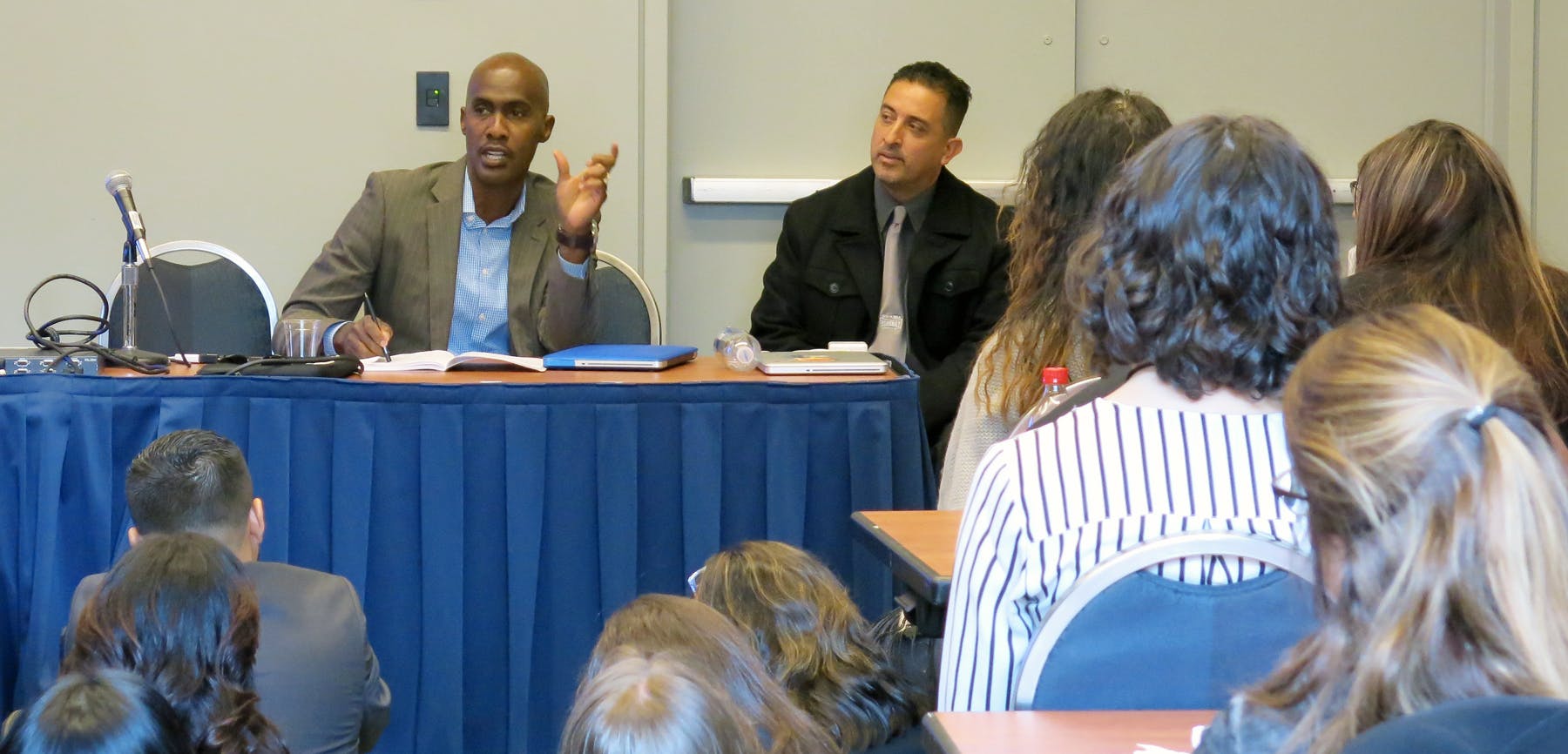While working at the LA-based nonprofit Homeboy Industries, Luis Giraldo (’10, M.A., Higher Education and Organizational Change) had a firsthand view of gangs and their culture. Moreover, having grown up in downtown Los Angeles, he had gained exposure to the gang lifestyle through friends and family.
“My background is very connected to my research,” says Girardo, who participated in a symposium on “The Prison-to-School Pipeline: Nondeficit Approaches to Examining the Educational Trajectories of Marginalized Latino Males” at the annual meeting of the American Educational Research Association (AERA) last April. “To be so close to this issue is impactful for me.”
The panel of scholars from throughout the UC system, included UCLA Education doctoral student Adrian H. Huerta (’12, M.A., Higher Education and Organizational Change) and Professors Walter Allen, Patricia McDonough, and Cecilia Rios-Aguilar, who presented their respective papers, “Cultural Capital and Habitus: The Influence of Gang and College Knowledge for Low-Income Latino Male High School Students” (Allen, Huerta, and McDonough); and “The Prison-to-College-to-Jobs Pipeline” (Giraldo and Rios-Aguilar). Professor Tyrone Howard and Diego Vigil (’76, Ph.D., Anthropology) served as the session’s discussants. The symposium was well received by a nearly standing-room only audience pf AERA attendees.

“There was a lot of excitement from the AERA reviewers who looked at our proposal,” says Huerta, who graduates this month with his Ph.D. from HEOC. “They were definitely excited not just about the topic but about the faculty and students who were part of the session. We received a lot of policy and practice-based questions from our audience.
“Typically, people talk about the school-to-prison pipeline,” he says. “When people talk about gangs or prison, most of the time they see it as a deficit. If we somehow flip it around and use students’ knowledge in a positive way, the results are very powerful.”
Giraldo, who recently completed his Ph.D. at Claremont Graduate University’s School of Educational Studies, worked as a facilitator in Homeboy Industries’ education program and continues to serve as a mentor to those who seek to turn their lives around. Now an adjunct faculty member at Pacific Oaks College in Pasadena and Director of Equity and Cultural Competency at Santa Barbara City College, he says that faculty and staff at community colleges need to learn how to better serve the previously incarcerated and gang-involved students who pursue a higher education.
“We need to inform our ways of providing training [for faculty and staff] and sometimes the training will come in the most unorthodox method, meaning that maybe former gang members are the best to [teach the] dos and don’ts of treating this particular group of individuals,” says Giraldo. “Members of Homeboy Industries go to campuses like UCLA, USC, and other local universities and talk about their experiences and how teachers should treat individuals like them who are in the [criminal justice] system and are trying to get out of it.”
Huerta says that “Cultural Capital and Habitus” evolved from his work with Professor McDonough and a paper he previously wrote on Latino male students’ perspectives on their options and knowledge about gangs, college, or joining the military. He says that there are a lot of connections between students’ ability to learn about what it takes to get to college and what it takes to join a gang, and that it would be ideal to replace the knowledge about gangs with information about how to get into college.
“There are a lot of connections because there is a recruitment process [for both gangs and college],” Huerta notes. “You have to have knowledge of specific areas of expertise, and you can excel in those areas if you have the right skills and understanding of how they work.”
Huerta also says that schools are responsible for the level of information that Latino male students acquire about higher education.
“Once students have the label of having been a gang member, a lot of school officials don’t want to talk to them about that pathway because they don’t think these students are college material,” he says. “Even if you put them in a different setting, they’re [perceived as] excelling in the streets but not in school.”
Giraldo says that community colleges further alienate former gang involved or previously incarcerated students, both through policy and their treatment of these students.
“With the proper guidance, [previously incarcerated or formerly gang-involved students] have been able to get into community colleges, but they’re misunderstood because of the way that they look,” he says. “When they walk in the door with the baggy pants and tattoos and the mannerisms of someone who was previously incarcerated or formerly gang-involved, they receive different treatment [although] they’re out of prison and have paid their dues for committing a crime. If you commit a crime that was drug-related, you are no longer eligible to receive financial aid and it is harder for you to become a college student.
“They’re hypervisible, but their needs are invisible,” says Giraldo. “Some of these individuals have spent 19 to 20 years in prison. But if you did time, why should you be punished retroactively? What I’m looking at is not how students like this should change who they are but how we can learn to accommodate them. They deserve as much respect as anybody else.”
Above: Adrian Huerta presented his co-written paper, “Cultural Capital and Habitus: The Influence of Gang and College Knowledge for Low-Income Latino Male High School Students” to an overflowing audience at a symposium on “The Prison-to-School Pipeline: Nondeficit Approaches to Examining the Educational Trajectories of Marginalized Latino Males” at this year’s AERA Annual Meeting.
